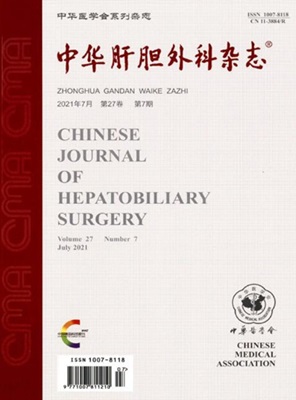肝脾手术后肝缺血/坏死及上消化道出血的CT和MR特征
Q4 Medicine
引用次数: 0
摘要
目的探讨肝脾手术后肝缺血坏死及上消化道出血的CT、MR影像学特点。方法收集36例经医学影像学和临床诊断确诊为肝脾切除术后不久肝缺血坏死和上消化道出血的患者,其中癌症切除9例,癌症消融术(微波消融术/射频消融术、氩氦刀、酒精注射)5例,脾脏切除11例,上消化道出血11例。进行常规肝脏CT和/或MR平扫和动态增强扫描,全面分析病变的形态和密度/信号表现。结果(1)病变数量:所有病例均有多发性病变。(2) 病变分布:散在肝叶,呈聚集性或区域性分布,主要分布在肝脏外围。(3) 病变大小:结节性病变边界清晰,单个最大直径1.0-1.5cm,可融合成楔形斑块或节段/亚节段大斑块,有轻微肿块效应。(4) CT密度或MR信号特征:CT平扫显示稍低密度;MR平扫T1WI稍低信号,T2WI高信号,DWI稍高信号,双相成像无脂/脂肪;36例中24例(66.7%)无强化,部分病灶边缘有薄环强化;门静脉主干和/或支出现栓塞(21/36例,58.3%)。(5)在短期复查(最少5天)中,病变变小或消失,局部肝体积变小或表面凹陷。结论肝脾手术后并发上消化道出血可发生肝缺血坏死。影像学表现为多发结节性或片状低血管病灶,短期复查显示明显改善。它需要与恶性肿瘤术后的感染和转移进行鉴别。关键词:肝切除术;脾切除术;上消化道出血;缺血;坏死;计算机断层扫描,X射线;磁共振成像本文章由计算机程序翻译,如有差异,请以英文原文为准。
CT and MR features of hepatic ischemia/necrosis after hepatosplenic surgery and upper gastrointestinal hemorrhage
Objective
To investigate the CT and MR imaging features of hepatic ischemia/necrosis after hepatosplenic surgery and upper gastrointestinal hemorrhage.
Methods
A total of 36 patients diagnosed with hepatic ischemia/necrosis by both medical imaging and clinical diagnosis shortly after hepatosplenic surgery and upper gastrointestinal hemorrhage were collected, including 9 patients with liver cancer resection, 5 patients with liver cancer ablation (microwave ablation/radiofrequency ablation, argon-helium knife, alcohol injection), 11 patients with spleen resection, and 11 patients with upper gastrointestinal bleeding. Conventional liver CT and / or MR plain and dynamic enhancement scan were performed to comprehensively analyze the morphology and density/signal performance of the lesions.
Results
(1) Number of lesions: All cases had multiple lesions. (2) Distribution of lesions: scattered in the liver lobes, clustered or regional distribution, mainly in the periphery of the liver. (3) Size of lesions: the boundary of the nodular lesion was clear, and the single maximum diameter was 1.0-1.5 cm. It can be fused into a wedge-shaped patch or a segmental/sub-segmental large patch with a slight mass effect. (4) CT density or MR signal characteristics: CT plain scan showed slightly low density; MR plain scan showed slightly low signal on T1WI, high signal on T2WI, slightly high signal on DWI and no lipid/fat on dual phase imaging; 24 out of 36 cases (66.7%) showed no enhancement, while some lesions showed thin ring enhancement on the edge; emboli were found in the main and/or branches of portal vein (21/36 cases, 58.3%). (5) In the short-term review (minimum 5 days), the lesions became smaller or disappeared, and the local liver volume became smaller or the surface was depressed.
Conclusions
Hepatic ischemia/necrosis occurs after hepatosplenic surgery and upper gastrointestinal hemorrhage. The imaging manifestations are multiple nodular or flaky hypovascular foci, and the short-term review shows a markedly improvement. It needs to be differentiated from infection and metastasis of malignant tumors after operation.
Key words:
Hepatectomy; Splenectomy; Upper gastrointestinal hemorrhage; Ischemia; Necrosis; Computed Tomography, X-ray; Magnetic resonance imaging
求助全文
通过发布文献求助,成功后即可免费获取论文全文。
去求助
来源期刊

中华肝胆外科杂志
Medicine-Gastroenterology
CiteScore
0.20
自引率
0.00%
发文量
7101
期刊介绍:
Chinese Journal of Hepatobiliary Surgery is an academic journal organized by the Chinese Medical Association and supervised by the China Association for Science and Technology, founded in 1995. The journal has the following columns: review, hot spotlight, academic thinking, thesis, experimental research, short thesis, case report, synthesis, etc. The journal has been recognized by Beida Journal (Chinese Journal of Humanities and Social Sciences).
Chinese Journal of Hepatobiliary Surgery has been included in famous databases such as Peking University Journal (Chinese Journal of Humanities and Social Sciences), CSCD Source Journals of China Science Citation Database (with Extended Version) and so on, and it is one of the national key academic journals under the supervision of China Association for Science and Technology.
 求助内容:
求助内容: 应助结果提醒方式:
应助结果提醒方式:


